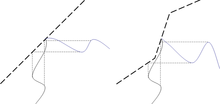Non-linear system
Nonlinear systems ( NL systems ) are systems theory systems whose output signal is not always proportional to the input signal (system stimulus). They can be much more complex than linear systems .
general basics
For non-linear systems, in contrast to linear systems, the superposition principle does not apply. This means that one cannot infer an unknown system response for a given system stimulus from several known system stimulus-system response pairs. Furthermore, one differentiates the non-linearity of a system into static , dynamic , single-valued and multi-valued non-linearity. Since there is no closed mathematical theory for nonlinear systems, there is also no general method for analyzing unknown nonlinear systems.
In general, a mathematical model of a non-linear system with an internal state , external influences and observations can be represented as
where and are the non-linear functions that describe the system.
Static nonlinear systems

Static non-linear systems are understood to be those that react to a system stimulus without a time delay. For example, the diode is generally viewed as a static component (with the exception of fast switching operations). Their voltage-current characteristic follows an exponential function; in various applications it is idealized and treated as piece-wise linear, but remains non-linear in the system-theoretical sense. Static systems can be described by a static characteristic curve as shown in the figures.

Above (for example at> 3 mA) almost linear: A sinusoidal course of a change Δ U GS generates a change Δ I D without a visible deviation from the sine curve.
Bottom (for example at <3 mA) non-linear: A sinusoidal course of a change Δ U GS generates a change Δ I D with a recognizable non-sinusoidal course.
Dynamic nonlinear systems
Dynamic non-linear systems are those that also have storage elements and thus a “memory”. As a result, the system response is not determined by the instantaneous value of the system stimulus alone. It also depends on the previous history, i.e. on the strength of the previous arousal.
Characterization with regard to the frequency behavior
When linear systems are excited with a sinusoidal signal, a sinusoidal signal of the same frequency is obtained at the output, but with a changed phase position and amplitude. Nonlinear systems generally do not have this property. Non-linear systems can have frequency components at their system output that are not contained in the input signal ( distortion ).
Examples from electrical engineering are:
- If a non-linear amplifier is fed with a single sinusoidal voltage as input voltage, it generates harmonics at the output in addition to a sinusoidal voltage . Their proportions increase with increasing overdrive .
- If the amplifier is fed with a superposition of two or more sinusoidal voltages of different frequencies, intermodulation also occurs, and combination frequencies arise.
- If several modulated AC voltages are to be amplified at the same time, cross modulation can occur. Then one alternating voltage partially takes over the modulation of the other ( Luxembourg effect ).
literature
- Mathukumalli Vidyasagar: Nonlinear systems analysis SIAMm Philadelphia 2008, ISBN 978-0-89871-526-2 .
- Muthuswamy Lakshmanan, et al .: Nonlinear dynamics - integrability, chaos, and patterns. Springer, Berlin 2003, ISBN 3-540-43908-0 .
Individual evidence
- ↑ Holk Cruse: Biological Cybernetics. Verlag Chemie GmbH, Weinheim 1981, ISBN 3-527-25911-2 .
- ↑ Dezsö Varjú: Systems Theory. Springer-Verlag, Berlin / Heidelberg 1977, ISBN 3-540-08086-4 .
Web links
- Literature on the nonlinear system in the catalog of the German National Library





